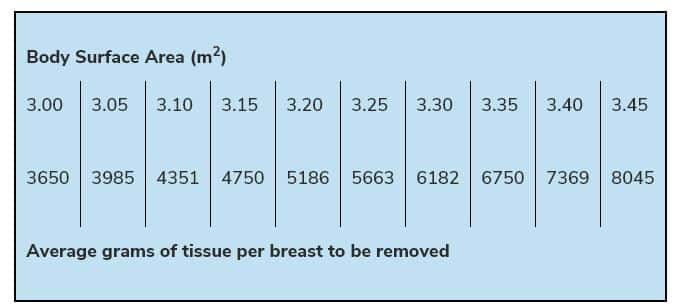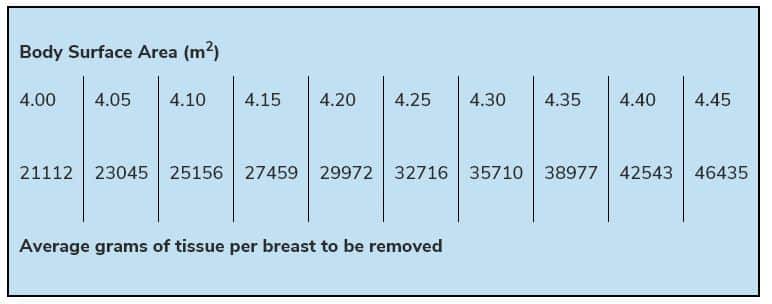Breast Reduction
Breast Reduction Surgery
Also known as a Reduction Mammoplasty
What is a Breast Reduction?
Reduction mammoplasty, often called breast reduction, is a surgical procedure to reduce, lift and reshape the breasts. It may also reduce the size of the areolas (the dark skin surrounding the nipple). Most women request a breast reduction to alleviate back pain, neck pain, shoulder pressure, strap pain, rashes or skin tags, as well as to improve the appearance of their breasts. 85% of patients are more than satisfied with the results of reduction mammoplasty. The procedure is performed under general anesthesia. The operation takes about 3 to 4
What to expect during the Reduction Mammoplasty procedure?

There are numerous techniques used to reduce the breast. Recent popularity has been given to procedures with minimal scar techniques – which involve: an oval incision from which the breast tissue is removed and the wound is then closed
Breast Reduction Techniques

Breast Liposuction is a recent attractive alternative for patients who seek no visible scars. This procedure is limited by the degree of laxity to the skin prior to liposuction. If there is significant laxity to the skin, then the degree of ptosis (drooping) may be worsened by the procedure. Secondly, the real possibility of difficulty reading a mammogram as a result of post-liposuction scarring must be weighed carefully, acknowledging that one in 8 women in the United States will develop breast cancer over a lifetime.
KEYHOLE, ANCHOR, OR WISE PATTERN INCISION
The breast reduction procedure often requires two incisions that are each made angled downwards and outwards from the base of the circular incision around the areola. The base of the 2 these incisions then are angled to the inframmary crease. Skin within this pattern is removed except for the nipple and areola, which remains attached to the underlying breast tissue. The pedicle can be based on a dermal blood supply and again looses sensation; or it can be an inferiorly or inferior and centrally based pedicle. I prefer the latter since it provides the best opportunity to preserve blood and nerve supply. During this procedure, the pedicle of the breast tissue is 8cm in width is left attached to the chest wall, the entire vertical height. The overlying skin flaps are then closed over the breast pedicle to form one vertical line after the fat and extra tissue on either side of the pedicle has been removed. One drain is then placed on the side of each breast, which is removed during the first clinic visit after surgery. The incisions are then closed with an absorbable suture and the surface glued in order to prevent scar widening and excessive scarring.
Free Nipple Graft Breast Reduction
In some cases, the nipple and areola are transferred as a skin graft to their new position. This is performed when the breast is very pendulous and the nipple must be lifted greater than 12 -15cms. The inferior/central pedicle technique would be unreliable in preserving blood supply in such cases. The disadvantage of this technique is that sensation is completely lost and in darker skinned patients there may be a partial loss of pigment for up to 2 years and possibly longer.
What to expect during the recovery for the Breast Reduction procedure?
After your Breast Reduction, your breasts will be wrapped in gauze dressings and an elastic bandage; a support bra will also help minimize swelling and support the breasts as they heal. Following breast lift surgery patients may experience discomfort, swelling, and bruising which typically lasts from two to three weeks. The sutures are generally removed from the breasts after a week or two. Patients are normally able to return to work and light activities after about a week. Prescription pain medications may make patients more comfortable during the first week of recovery.
Examples of Breast Reduction Results:

Insurance Criteria for Breast Reduction
Criteria for
By way of example, Aetna’s criteria
a. patients must be at least 18 yrs old,
b. referred by another physician who supports surgery,
c. at least 1 yrs duration of at least 2 of the following: back/neck/shoulder/strap pain and or grooving, painful x-ray documented kyphosis or headaches,
d. at least 3 months without
e. if aged 40 and above, a mammogram within 1 year of the planned surgery,
f. a Polaroid photograph anterior and lateral of the breasts to be sent with the written request for surgery and
g. the patient’s full understanding that the amount of breast tissue to be removed will follow a calculation called the ‘Schnur Scale’ ( Schnur, Paul L, et al., “Reduction Mammaplasty: Cosmetic or Reconstructive Procedure?” Annals of Plastic Surgery. Sept 1991; 27 (3): 232-7 ). Body surface area in meters squared: BSA (m2 ) can be calculated using the following simple equation = height (in) x weight (lb) / 6262 . A 140 pound 5 foot







Frequently Asked Questions
To find out more about available treatments and procedures, request a consultation with Dr. Moulton-Barrett at one of his Bay Area offices. Board certified plastic surgeon Rex Moulton-Barrett, M.D., offers advanced care and procedures for Bay Area residents. He has offices in Alameda and Brentwood, CA.
BREAST PROCEDURES
Our Clinics
Alameda Clinic
2070 Clinton Ave
Fourth Floor
Alameda, CA 94501
Phone (510) 864-1800
Brentwood Clinic
1280 Central Blvd
Suite J-5
Brentwood, CA 94513
Phone (925) 240-8775
ALAMEDA OFFICE
BRENTWOOD OFFICE
Alameda Location
2070 Clinton Ave, Alameda, CA 94501
510-864-1800
Brentwood Location

